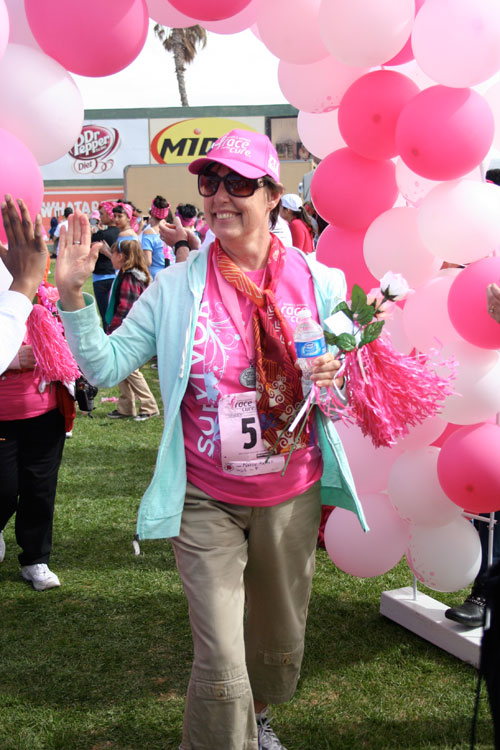EL PASO — Breast cancer killed her mother, hit her sister 15 years ago and five years ago Nancy Hansen was diagnosed with the illness.
A theatre and speech teacher at Irvin High School, Nancy Hansen walks in the Susan G. Komen Race for the Cure every year, in memory of her mother and to participate in the battle against the illness that has affecter her and her family for so long.
Taking part in Race for the Cure was always something that Hansen took part in before becoming a survivor. Her mother died of breast cancer that spread into her liver and bones 35 ½ years ago.

12,000 El Pasoans gathered at Cohen Stadium in Northeast El Paso for the 19th annual Susan G. Komen Race for Cure on February 20. (Diana Amaro/Borderzine.com)
“Cancer sucks,” Hansen said, “and I want to do what I can. I don’t want any cancer to be around so I work with breast cancer because I’m a breast cancer survivor.”
An estimated 12,000 El Pasoans took part in the 19th annual Race for the Cure on Sunday, February 20. Participants ran, walked, or jogged in memory or celebration of their family members, friends, or themselves. People of all ages came out and filled the streets of Northeast El Paso to support those individuals in their lives that have been affected by breast cancer.
Out of the thousands participates that took part in this race; hundreds of them were survivors, ranging from 25+ years to less than a year. The large turnout for this year’s event was something that Hansen did not forget as she walked along side her sister and a thousand others.

Nancy Hansen, a theatre and speech teacher at Irvin High School and a 5 year breast cancer survivor, walks through the Survivor Ceremony that commemorates the survivors of this illness that has affected so many. (Diana Amaro/Borderzine.com)
“That is so cool! Going down Diana and you look back up and you can see all these people and you look forward and you can see all these people and it’s just a wonderful feeling. It was great when it was 3 and 4 thousand but its really getting better and better. The more people, the more wonderful it is.”
After the completion of the race, a survivor’s celebration is held in commemoration for them. Survivors line up according to how many years they have been survivors and parade down an isle of their loved ones cheering them on. Once they have all gone through the procession, survivors stand together on bleachers waving pom poms and grasping the cheers from their loved ones who have gone to take part in this special event with them. After some individual speeches are made and music fills the air for their celebration, doves are released into the air as everyone watches below.
“I liked it [the race] when I was walking because of mother and when I was walking because of my sister but going through the survivor celebration is just, I cry every year,” Hansen said, “especially when the doves go.”
According to BreastCancer.org, “In 2010, an estimated 207, 090 new cases of invasive breast cancer were expected to be diagnosed in women in the U.S.” Despite the fact that thousands of new cases of cancer were brought forth in 2010, it is also stated that, “in 2010, there were more than 2.5 million breast cancer survivors in the U.S.” Catching cancer at an early stage is the best possible way for survival. Conducting monthly exams is what can help an individual increase their changes in catching cancer at an early stage.
“You need to do a monthly self-exam or at least a regular one,” Hansen began to state, “I found my lump. I had what I called cancer-lite because compared to what some people go through, mine was nothing because I found it and I found it early. All cancers the earlier you find it, the better your chances of survival.”

White doves fill the sky as they are released in celebration of the hundreds of breast cancer survivors who took part in Race for the Cure. (Diana Amaro/Borderzine.com)
Every year, nation-wide, Race for the Cure has brought thousands of people together; thousands of pairs of feet walking for those they love. Those who take part in this event do it for their moms, grandmothers, sisters, aunts, cousins, and friends. They take part in it to show their support for those affected by cancer and come together as a community to raise awareness to this disease that has affected so many.
Hansen is just one of the many women who have been affected by cancer both directly and indirectly. She has gotten through her mother being diagnosed and passing away from cancer; she has gotten through her sister being diagnosed and surviving cancer; and now is getting through herself being diagnosed with cancer and celebrating her survivorship. She cannot express the importance of conducting a self exam because an exam like that saved her life and it can save many, many more women every year.
“Go to your mother or grandmother or both and ask ‘Mom? Do you do a monthly self exam?’ and when they look at you in shock and horror say ‘Mom I love you, I don’t want you to get cancer but if you do, I want you to get it the way Ms. Hansen got it…I want you to survive.’”


Hi Diana,
Great video! Call me if you would be interested in taking more video of our events.
thanks,